
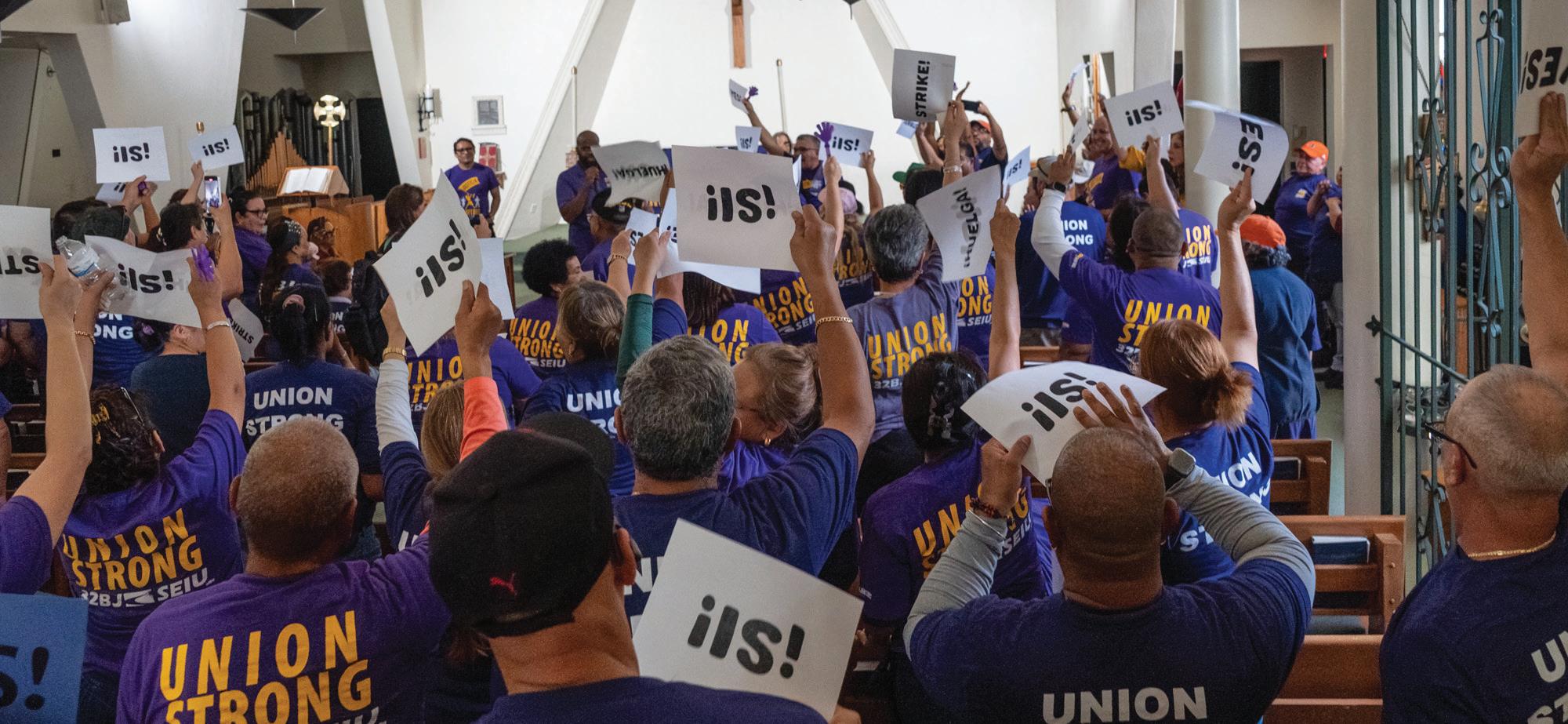



By Mel Tenkoff Managing Editor
More than 364 janitors, groundskeepers and maintenance workers at the University of Miami voted “yes” to authorize a strike at a rally held at noon on Monday, Aug. 18.
If no agreement is reached between ABM, UM’s cleaning contractor, and the employees’ union, the strike will occur after the current contract expires on Aug. 31, 2025.
The workers employed by ABM are members of Service Employees International Union Local (SEIU) 32BJ. The union represents the staff who clean dorms, classrooms, UHealth medical facilities, including the Lennar Center and Sylvester Comprehensive Medical Center, and many other areas of campus.
“Nosotros somos los empleados que estamos limpiando la universidad … porque nosotros trabajamos para ustedes” [We are the employees who clean the university … we work for you], said Candida, who is a custodian at the Shalala Student Center. She added that janitors need better salaries because life in Miami is extremely expensive, and their wages have not kept up with inflation.
The workers rallied outside of
Saint Bede Chapel on UM’s Coral
Gables campus, demanding a new contract that reflects Miami’s soaring cost of living and recognizes their role in keeping the university’s facilities safe and clean for students, faculty and patients.
Many more workers gathered on Ponce De Leon Boulevard encouraging student support and handing out flyers reading: “Welcome back. Your janitors are ready to strike.”
“Many [ABM workers] are housing insecure or even skipping meals,” said 32BJ SEIU’s Regional Communications Manager Ana Tinsly. “It’s embarrassing considering that they’re cleaning and maintaining one of the most expensive and luxurious universities in the country. There is no excuse for the workers who keep UM safe and operational to be earning poverty wages.”
Service workers at UM first started a union in 2006 after an initiative that included a 17-day hunger strike drew national attention. This effort led to major improvements at the time, including employer-funded health care, paid sick leaves and stronger workplace protections.
Nearly two decades later, the union argues that those hard-won gains are no longer being honored to keep up with the expenses of living in Miami.
Workers at the rally echoed that
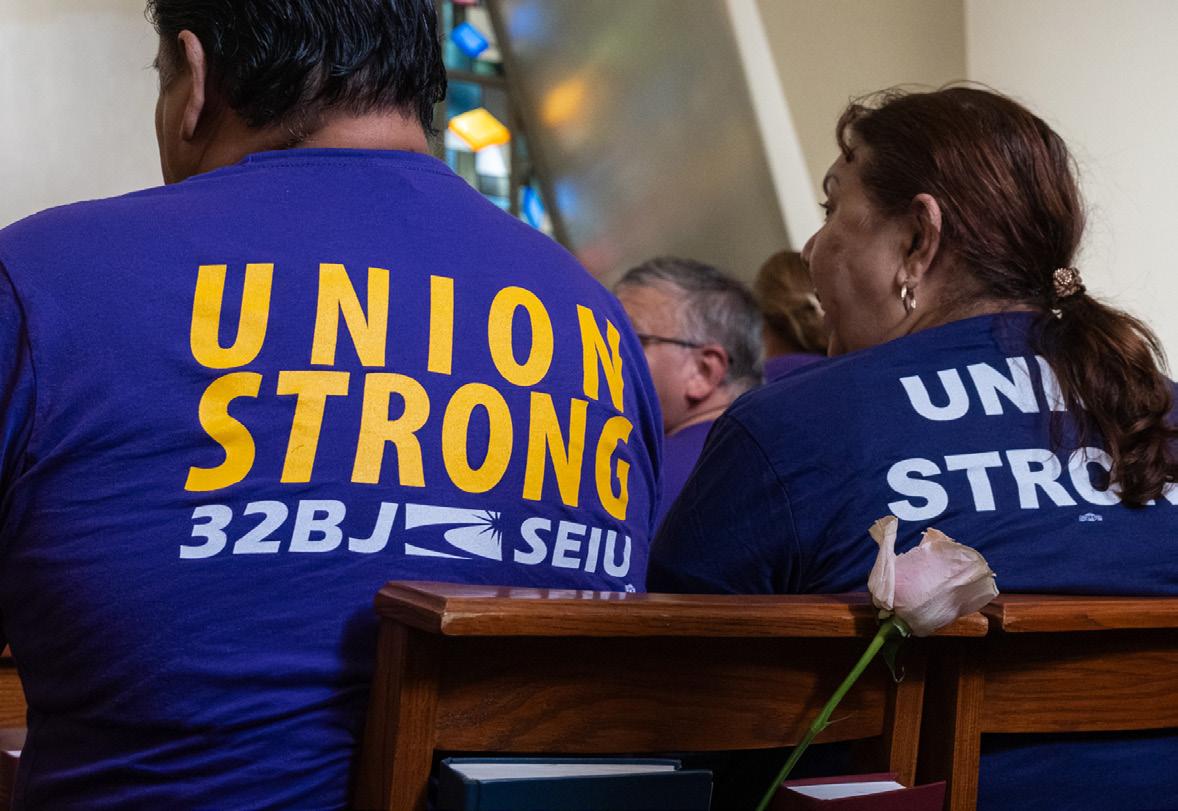
frustration, saying that they feel disrespected by the company’s proposals and that history is repeating itself as the union members struggle to make ends meet once again.
“No alcanza salario y no nos quieren aumentar nada y no hay respeto” [Our salary is not enough and they don’t want to give us any raise and there is no respect], said Victoria Carvajal, a cleaner in the Ashe Building.
According to estimates from MIT Living Wage Calculator, a single adult in Miami-Dade County needs to earn about $24.77 an hour, or approximately $4,294 per month, to cover basic expenses, including housing, transportation, food and healthcare. Typical monthly costs in the county are about $1,718 for housing, $670 for transportation and $404 for food.
In contrast, ABM workers at UM start at $14.25 an hour, which is about $2,470 a month before taxes for those who work 40 hours a week. The figure falls nearly $1,800 short of the monthly living-wage estimate.
Many janitorial workers are left living paycheck to paycheck, part of a greater trend where close to 50% of households in Florida cannot afford basic necessities, according to United for Alice.
“We are currently negotiating in good faith with SEIU to reach an agreement that is fair to both
our team members and [the University of Miami],” ABM said in a statement to The Hurricane. “We remain hopeful that we will soon find common ground and a shared path forward.”
According to the SEIU, the company has offered an unacceptable 50-cent raise per year and suggested eliminating the training fund, which provides workers with English classes and career-advancing certifications.
In a statement to The Hurricane, the University of Miami said that ABM staff are not employed by the institution, and that the dispute falls beyond the University’s authority.
“The University appreciates its long-term relationship with both ABM and SEIU and is hopeful the two sides reach an amicable agreement,” the University said in its statement.
Union representatives also criticized ABM for refusing proposals for free campus parking, which they say forces workers to spend hundreds of dollars each year just to get to their jobs.
The efforts are supported by local elected officials, including South Miami Mayor Javier Fernandez and Miami Commissioner Christine King. King, who attended the event, emphasized the importance of siding with those who receive low wages.
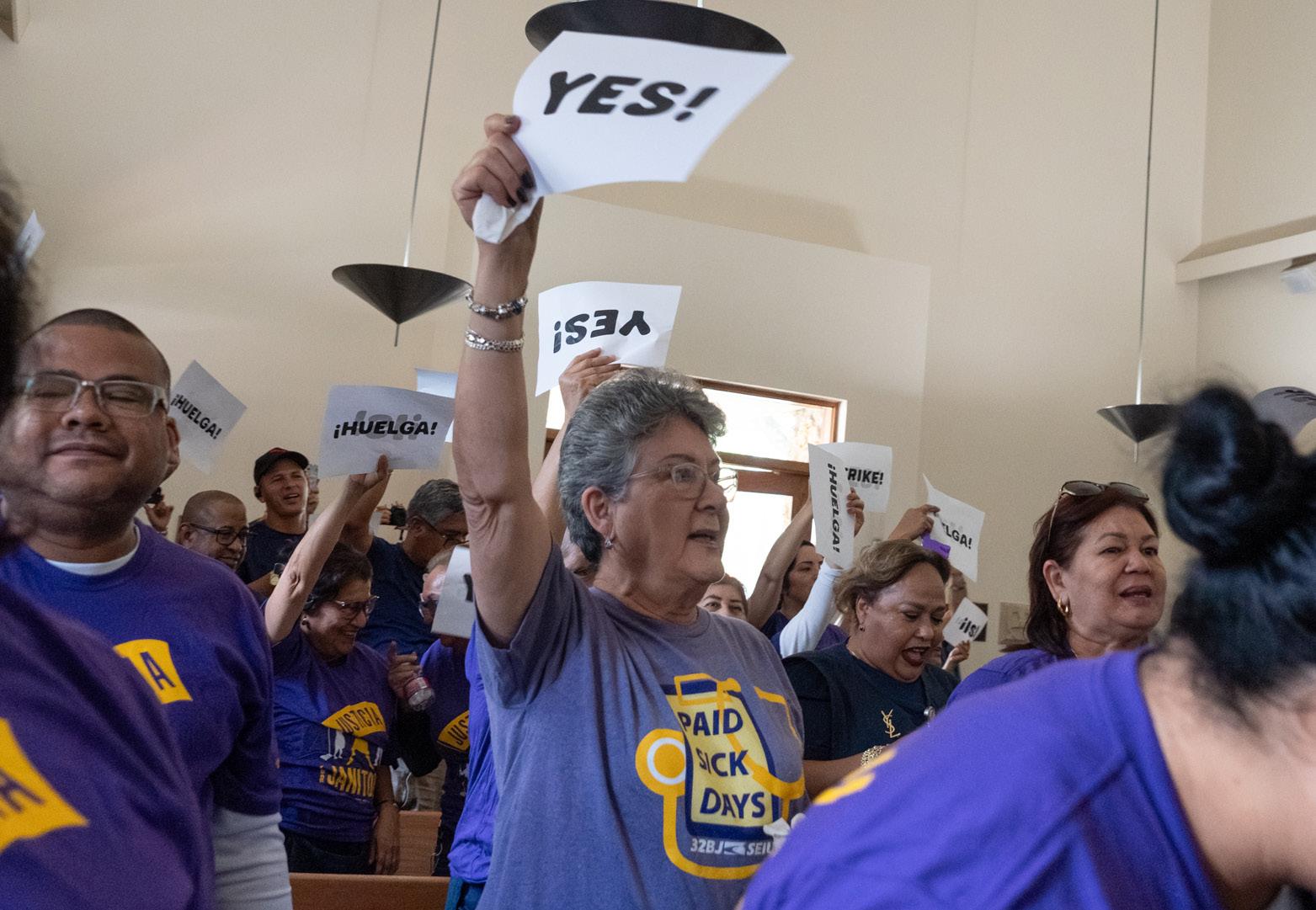
“We have to stand up for [our janitors] because they are the lowest paid but they do the most important work,” the Commissioner said.
The Union is also looking to students to advocate for their cause. At the rally, organizers handed out posters and encouraged students to attend in solidarity.
Helene O’Brien is the Vice President of 32BJ SEIU, which represents more than 185,000 workers. O’Brien says that these hardworking people not only provide for students, but love them as part of their community, and now, they need students to stand with them in return.
“Students went on a hunger strike with [workers] back in 2006. You may not realize, but they love the students and many of them are here for them,” she said. “The students are essential.”
By Elena Fallow & Martina Pantaleon
Editor & Senior Staff Writer
By Ariana Glaser Contributing Writer
By Jenna Simone
Daniella Krasney and Emil Salgado Vazquez contributed to this reporting.

By Elena Fallow & Martina Pantaleon Assistant News Editor & Senior Staff Writer
The University of Miami announced new transportation policies that restrict “micromobility devices” — a form of personal transport powered by a motor with or without a saddle and no more than three wheels — beginning fall 2025.
According to UM’s website, the policy prohibits electronic micromobility vehicles. E-bikes, hoverboards, e-scooters and similar electronic micromobility vehicles may not be used on pedestrian walkways, stored indoors or charged on campus.
While the University supports sustainable transportation, concerns like pedestrian safety, fire hazards from lithium batteries and obstruction of emergency exits ultimately led the University to implement this new policy.
Sophomore Harper Smith is glad to see the e-scooters go.
“Scooter drivers never give pedestrians the right of way.” she said. “They cut [pedestrians] off or almost run them over.”
Sophomore and former e-scooter owner, Jared Hinojosa, also agrees with the University’s decision to restrict micromobility usage.
“Scooters are really dangerous, I fell off my own scooter multi -
freshmen hit by car on US Route 1, one hospitalized
By Katie Karlson Editor-in-Chief
Two students were hit by a car on South Dixie Highway, a segment of U.S. Route 1, on Saturday, Aug. 16 around 6:30 p.m.
The students are freshmen living in Mahoney Residential College.
“One student was struck by a car making a left turn and was transported to the hospital. That student is expected to be discharged soon,” the University of Miami said in a statement to The Hurricane. “The second student was also struck, but did not require hospitalization.”
Many other students started learning about the incident later that same day, expressing concern for their fellow ’Canes.
“Around 9 p.m., one of my friends mentioned that two students who live on Mahoney floor three were hit by a car while returning from CVS on U.S 1 earlier in the evening,” said a student who wishes to remain anonymous and resides in Mahoney-Pearson Residential College. “My friend told me that they saw around 9 ENTs in the area after the accident happened. My hopes and prayers go out to the students affected.”
Multiple other students have been injured or passed away due to being hit by cars at this busy intersection. After years of lobbying and UM administration and students pushing for a solution, a pedestrian bridge spanning U.S. 1’s six lanes opened in 2017.
The students hit on Saturday are receiving assistance from UM and should hopefully continue the semester in a more positive manner.
“Student Affairs and Housing and Residential Life staff has provided support to both students,” said the University.
ple times and hurt myself,” the sophomore said. “I think this will be a good change and reduce the chance of people being injured by scooters,” he said. “Although it was a great way of getting from one place to another, especially as
“I think this [new policy] will be a good change and reduce the chance of people being injured by scooters.”
Jared Hinojosa UM Sophomore
a freshman without a car, I am not shocked at their decision.”
While restricting the usage of electric micromobility vehicles means safer walkways for pedes -
trians, some say it puts student athletes at a disadvantage.
Sabrina Fernandez, a sophomore member of the women’s rowing team, is not happy with the University’s updated policy.
“This restriction removes a tool that provides essential convenience and time management for my academic success and athletic performance,” Fernandez said. “I believe the University should consider how such policies disproportionately affect certain communities of students.”
She felt it was unfair that individuals who operated their micromobility devices responsibly are being unfairly punished by the new policy.
“My scooter is registered, and I have always respected traffic rules and operated it cautiously,” Fernandez said. “Maintaining this privilege is critical for students like me to succeed in both academics and athletics.”
Non-electric bicycles, motorized wheelchairs and other mobility assistance devices that have been approved by the Office of Disability Services and the Office of Workplace Equity and Inclusion are still permitted on campus.
Micromobility devices are not allowed on popular pedestrian walkways such as the Foote Green, Lakeside walkways and breezeways, meaning they can only be used on the exterior parts of campus.
Only registered devices are al -
lowed to park at designated parking racks, located at the exterior
“This restriction removes a tool that provides essential convenience and time management for my academic success and athletic performance.”
Sabrina
Fernandez UM Sophomore
parts of campus near approved e-scooter paths, as shown on the
school’s micromobility map. According to section 4.1 of the micromobility policy, parking your device next to campus structures like handrails, stairwells, trees, fences, benches, light poles and signs is not permitted.
Any violations of this policy may result in a citation, impoundment of the device or disciplinary action. Section 4.3 of the policy outlines in detail additional consequences such as citations under Florida Statute 316.2065 and fines.
Non-registered bicycles or scooters will have a $25 impoundment fine and will be confiscated by UMPD, with an additional $5 every day it is stored.
The Office of Parking and Transportation encourages faculty and students to kindly inform those who may not know about the new policy and remind those disregarding it. The office also asks that everyone familiarizes themselves with the new policy and micromobility map.
These modifications are subject to change. Once incorporated, UM will listen to the community’s feedback and modify accordingly.
“The University will assess the policy’s effectiveness after the initial rollout and may make adjustments based on community feedback and safety data,” says the Office of Parking and Transportation.
The University of Miami did not respond to multiple requests for comment.
By Zach Cohen Senior Staff Writer
JetBlue Airways, known for offering comfort and affordability, announced that it will no longer service Miami International Airport (MIA) starting on September 3.
The stoppage in service is due to financial trouble, unprofitable margins and low performance on the Boston to Miami route. JetBlue’s financial struggles began in early 2020, but worsened significantly in 2024 after a failed $3.8 billion merger with Spirit Airlines. Federal judges blocked the deal, citing concerns that it would eliminate lowcost options for passengers who depend on Spirit’s lower fares. In Q1 of 2024, JetBlue reported a loss of $716 million, which continued to decline through the end of the year into 2025. The losses, primarily driven by rising fuel costs and a decline in passenger demand, have left them projected to remain unprofitable through 2025.
JetBlue has been in service at MIA since 2021 and at its peak offered 14 daily flights including the New York
City area, Boston and Los Angeles.
In an effort to attract leisure travelers, the airline expanded service to Miami, positioning themselves as a competitor to Delta Air Lines and American Airlines, the ladder of which having a hub in Miami.
The New York-based carrier will still offer daily service to Fort Lauderdale and West Palm Beach.
Until September 3, JetBlue will offer 1-2 direct flights only to Boston. According to JetBlue, passengers
who booked flights to Miami after September 3 will either be able to fly to Fort Lauderdale or receive a full refund to their original form of payment, according to a spokesperson from the airline.
In addition to ending service at MIA, the airline is also scaling back operations from Seattle-Tacoma International Airport. JetBlue CEO Joanna Geraghty claimed that it is “unlikely” the airline will even reach break-even operating costs in 2025.

“We’re hopeful demand and bookings will rebound, but even a recovery won’t fully offset the ground we’ve lost this year and our path back to profitability will take longer than we’d hoped. That means we’re still relying on borrowed cash to keep the airline running,” Geraghty said in a note to staff, according to CNBC. With the departure of JetBlue, American Airlines, MIA’s primary carrier, may see a boost in passenger traffic, with Delta Air Lines potentially benefiting as well. JetBlue’s decision to leave MIA could impact many University of Miami students residing in the Northeast looking for affordable travel, especially around busy periods like holiday breaks. Now, it can be even more expensive for students to fly home given that MIA’s main carriers, American and Delta, have less competition and more demand. Students will have no choice but to pay the pricey fare to get home to their families. While Fort Lauderdale can be a good alternative, it is further from campus and may be less convenient based on the traveler’s location.
UM under federal investigation for allegedly providing scholarships to undocumented students
By Katie Karlson Editor-in-Chief
The U.S. Department of Education Office for Civil Rights opened an investigation into the University of Miami’s U Dreamers Program for allegedly breaching civil rights laws by providing specific scholarships to students without permanent legal status.
UM’s website states that the U Dreamers Program is “available to academically talented and admissible Deferred Action for Childhood Arrivals (DACA) and undocumented high school seniors and transfer students.”
According to the DOE website, providing scholarships specifically to “Dreamers,” undocumented immigrants who came into the U.S. as children, is a violation of Title VI of the Civil Rights Act of 1964, which prohibits against discrimination on the basis of national origin.
The DOE is investigating claims that the U Dreamers Program provides “unlawful exclusionary funding based on national origin.” The DOE’s investigation will determine if UM is “granting scholarships only for Deferred Action for Childhood Arrivals (DACA) or ‘undocumented’ students.” This investigation began due to
complaints from the Equal Protection Project. EPP is “devoted to fair treatment of all persons without regard to race or ethnicity,” according to its website. The EPP is associated with the Legal Insurrection Foundation,which is “widely recognized as one of the leading conservative law and politics websites.”
UM is one of five schools under investigation. The four other schools are the University of Louisville, the University of Nebraska Omaha, the University of Michigan and Western Michigan University. Through this program, UM commits to meeting “100% of demonstrated financial need for admitted
students,” including tuition, fees, housing, food and other expenses. First-year and transfer DACA and other undocumented applicants are required to provide their country of birth and number of years they have lived in the U.S., but they must “attest that they will not require a student visa for university study in the U.S.” The “terms and conditions” section of the U Dreamers Program page also outlines that if a student in the U Dreamers Program has a citizenship change that enables them to qualify for federal student aid, the funding from the program will be taken away. The University has not responded to any request for comment.
By Martina Pantaleon Senior Staff Writer
The University of Miami admitted just 17.55% of applicants for fall 2025, its lowest acceptance rate in half a decade, after receiving a record of 58,139 applications. That total marked a nearly 8% increase in applications from last year.
Admission rate and number of applicants
A decade ago, UM’s admission rate was near 40%. Since 2022, it has stayed below 20%
UM has continued to be Florida’s most selective college. The last two fall cycles (2024 and 2025) have retained its 18% acceptance rate (rounded up to 19% in 2024) despite the number of applicants increasing by 5,000 in 2025.
While this year’s class admissions statistics remained similar to that of 2024, reinstated testing requirements for fall 2026 could make a difference. 2021 saw a 33.5% drop in admitted students after standardized testing results became optional even though UM received 7,000 more applications.
GPA, SAT and ACT scores
Both the SAT and ACT 50% superscores stayed largely the same from fall 2024 to fall 2025, however both ranges changed slightly. The SAT narrowed its range from 1350-1510 in 2024 to 1360-1480 in 2025. The ACT score expanded a point, changing from 31-34 to 30-34.
Although UM became test-optional, GPA remained a standard academic metric required for all applicants. When using it as part of the admissions process, UM shows applicants’ GPA in an average unweighted 4.0 scale.
Data from fall 2024 show an average high school GPA of 3.8, comparable to 2025’s 3.89 average.
UM has been recognized for admitting students from a diverse number of countries. 2025’s incoming class showed a one percentage point increase in international students from 7% to 8%.
The percentage of admitted Florida residents has also increased from 29% to 32%.
Despite the decrease in Black enrollment reported in 2024, the incoming students self-identifying as people of color has increased by two percentage points to 46% from last year’s 44%. Students who identify as white non-Hispanic fell from 53% to 50%.
Aside from changes in birthplace and ethnicity, UM’s student body continues to get increasingly female.
The fall 2025 class has 55% female students, 10 percentage points above males and two percentage points more than 2024. This is part of a greater college enrollment trend — women make up roughly 55% of all students enrolled in university nationwide and in recent years have outpaced men in completing bachelor’s degrees.
By Ross Kluger Assistant News Editor
Two freshmen at the University of Miami already arrived prepared with years of passion and hard work, even just days into their first semester.
Ella Leon and Diego Selem have spent the last couple of years working together on a shared dream: making electric vehicles safer, smarter and more sustainable through their startup, Diselca.
Leon, CEO of Diselca, is originally from Israel, where she picked up English, Spanish, Hebrew, Russian and French before studying business law at UM.
Selem, CTO and founder of their company, is pursuing mechanical engineering at UM and brings prior startup experience to the team through GumGauge, his first engineering project in high school.
“We’re essentially looking to reduce the flammability, increase the mileage and make batteries safer overall,” Leon said, when asked about Diselca’s mission.
“We want to bring the benefits of solid-state technology right now, but without the price tag.”
To do this, Selem and Leon are focusing on improving the batteries already in use, specifically by experimenting with changes to the electrolyte – a liquid that carries charge inside lithium-ion cells.
Their idea first arose during an extended five-month summer break after their high school let them graduate early.
During that time, Selem faced a unique challenge. He was in the process of applying for residency in the United States but was unable to secure a job permit. Instead of letting the time slip away, he asked himself a bigger question.
“I didn’t really know how to be productive with my time,” Selem said. “So I thought, why not start an engineering startup? And that’s how it all began.”
That moment sparked the idea for Diselca, which he soon shared with his high school friend Ella Leon.
said. “Now, we’re fully focused on turning it into a reality.”
From those early conversations, the startup began to take shape.
The company’s name, Diselca, blends both Selem and Leon’s first names – Diego and Ella – as a reminder of its co-founder roots.
While Diego focused on deep en
“We’ve spoken to people in fire departments across the country, and we’ve come to the conclusion that there is a really big issue with vehicle flammability – it is leading to billion dollar recalls,” said Leon.

Selem echoed Leon’s point, noting that while solid-state batteries are often described as the future, the cost and difficulty of rebuilding factories worldwide makes them, in his view, “very far fetched” for manufacturing at scale anytime soon.
The batteries are not currently being produced, but Leon shared that they are discussing having some of their batteries manufactured and tested at UM.
“We’ve had a lot of positive support from professors, and it’s been amazing to even discuss having some of our batteries made and tested here at UM,” Leon said.
“Knowing I don’t have to choose between academics and the startup is something I really value.”
Early stage backing has come from individual investors, with Leon describing interest across “multiple sectors,” including a family of Tesla owners who faced “very similar issues” to those Diselca aims to solve.
While the technical hurdles are steep, both founders stressed the importance of resilience, and how it has been pivotal in the startup journey.
Diego commented on the numerous “roadblocks” they’ve hit already, but how their mindset is what makes the difference.
Leon put it simply: “As long as you have the mindset to persevere, you always will.”
Trump Administration requires universities report applicants’ race, statistics
By Elena Fallow Assistant News Editor
The Trump Administration ordered the Department of Education (DOE) to collect data regarding the race, gender, test scores and grade point averages of college applicants to assess whether universities are giving preference to minority applicants.
The press release from the DOE states that “institutions of higher education will now have to report data disaggregated by race and sex relating to their applicant pool, admitted cohort, and enrolled cohort at the undergraduate level and for specific graduate and professional programs.”
According to the press release, the data being collected are “quantitative measures of applicants’ and admitted students’ academic achievements such as standardized test scores, GPAs and other applicant characteristics.”
This directive grants the DOE the power to limit aid to institutions should they not agree to provide student information. This order follows the Supreme Court’s 2023 decision that effectively eliminated affirmative action in college admissions.
In an interview with The New York Times, Secretary of Education Linda McMahon said that this new order “will ensure meritocracy and excellence once again characterize higher education.”
On the contrary, UM sophomore Caleb Marcella, who identifies as Black and Latino, finds the Trump
Administration’s new policy odd.
“I think it’s unfortunate and just plain weird,” Marcella said. “If a student is accepted, they were accepted for a reason not just because of their race.”
“We are all the future of America and should be chosen for college based on hard work, dedication and achievements instead of just our ethnicity.”
Anonymous UM Student
In an interview with The New York Times, Richard Kahlenberg, an advocate for class-based affirmative action who served as a wit-
ness for Students for Fair Admission in the Supreme Court case, said that he believes additional data needs to be included in this new order.
While Kahlenberg agrees that admissions transparency is important, he also warned that the White House’s order would be incomplete without taking into account the student’s socioeconomic status.
“By failing to request the socioeconomic data, it looks like the administration is going to take us down this very extreme path where a university that achieves racial diversity is suspect, even if it uses a race-neutral means like socioeconomic status,” said Kahlenberg.
Research shows that a student’s test score closely correlates with his or her socioeconomic status. Statistically, Black and Latino students are more likely than white and Asian students to come from lower-income backgrounds.
Despite this statistic, an anonymous student who identifies as Hispanic agrees with the Trump Administration’s decision.
“I was a straight-A student in high school and had a lot of extracurriculars with leadership positions,” the student said. “I worked hard to earn my spot, and I am very passionate about learning more to help others in the future.”
While the student is proud of his or her heritage, the student is also proud of the accomplishments that lead to his or her to success.
“We are all the future of America and should be chosen for college based on hard work, dedication and achievements instead of

just our ethnicity,” the anonymous student said.
Some people also believe that this new ruling is an opportunity for hard work and merit to pay off, but others are skeptical of the Trump Administration’s true intentions.
Stephron Allyson, a Black sophomore at UM, is unsure of the Trump Administration’s motivation.
“Considering the other executive orders and issues [Trump] has had with other universities, I don’t think this new rule of requiring GPA and test scores is for the rea-
“I feel like the decisions the Trump Administration made does not reflect any care or concern about the education of students.”
Stephron Allyson UM Sophomore
sons being stated,” he said.
He believes there are holes in the administration’s explanation that leave room for questions.
“I feel like the decisions the Trump Administration made does not reflect any care or concern about the education of students,” Allyson said.
While the court ruled against affirmative action and admitting students based solely on the applicant’s race, it is still a factor that can be included in parts of a student’s application.
The opinion of the court states, “Nothing in this opinion should be construed as prohibiting universities from considering an applicant’s discussion of how race affected his or her life, be it through discrimination, inspiration, or otherwise.”

By Ariana Glaser Contributing Writer
Undoubtedly, ChatGPT has become an increasingly popular tool for college students over the last couple of years. But as the AI generative platform becomes more mainstream, people have found a new, far more lethal role for it to undertake: the role of a therapist. The fact remains that AI is no replacement for human connection, and using it as such can lead to detrimental impacts on mental health.
If you’ve spent any time doomscrolling through TikTok these past few weeks, you’ve likely encountered the ill-fated “romance” between Kendra Hilty and her psychiatrist. But in case you missed it, an ADHD patient fell in love with her psychiatrist of three years. She then accused the psychiatrist of manipulative and predatory practices because he allowed her emotional attachment to progress.

While it’s difficult to know which of these two parties was truly in the wrong, there was a clear enemy in the story: the AI chatbot that she nicknamed Henry and went to for advice.
Kendra described several in-
stances where she asked her AI companion for psychological support. As she scrambled through her thoughts sur rounding her complicated relationship with her unnamed psychiatrist, Henry provided in-depth, psy choanalytical perspectives that only served to reinforce the portrait she’d craft ed in her head.
Media reports argue that chatbots are built to mimic your tone and remember your mental ities. They’re built to be your friends — not your therapists.
For exam ple, if you feed ChatGPT a novel you wrote, it’s going to tell you that it belongs with literature’s greatest classics — even if it real -

ly, really doesn’t. In the same vein, if you tell a chatbot about a difficult situation, it will find a way to paint you as the victim. There’s been the recent phenomenon of “AI psychosis” – an ideology enunciating the idea that AI chatbots may exacerbate schizophrenic-like symptoms. Just last fall, a fourteen-year old committed suicide after developing a “relationship” with an AI-replica of a “Game of Thrones” character. A licensed therapist would have seen the warning signs, because a human being is capable of interpersonal connection in a way artificial intelligence will never be.
Trained mental health professionals serve to problem-solve while chatbots serve to fan egos. While we can all use positive reinforcement every now and again, being consistently placed on a pedestal cannot possibly be sustainable. If anything, ChatGPT’s dedication to centering its respective human being as the hero in every situation only serves to strengthen narcissistic tendencies and superiority complexes.
ChatGPT is far too new for us to know all of its long-term effects. But even in the short-term, we’ve seen the catastrophic consequences of replacing human connection with artificial intelligence. If we’re seeing AI as a friend — when it’s actually a subservient robot voicing what it knows we want to hear — we’re dooming our social skills. Therapy is expensive, and we all need someone to talk to when it comes to stressful academics and extracurriculars. But utilize your other resources like UM’s counseling center, advisors and professors, or your friends. Let Kendra’s story be a lesson to us all that there are some roles artificial intelligence should never replace — and the role of a therapist might be at the top of the list.
You don’t have to be a “UMiami girl” to fit in
By Keira Faddis Co-Opinion Editor
When most people think of UM, their minds immediately go to designer bags, expensive brands, parties and bikinis. If you scroll through the #UMiami on TikTok, you’ll find countless videos of this staple stereotype.
While it is true that many students may find themselves fitting in with the Miami girl cliché, it is completely okay if you don’t.
The term “UMiami girl” is used by mainly non-UM students to describe the stereotypical, trendy girls you see on campus. She could be filming a “day in my life” video on TikTok while sipping a matcha latte from the Honey Veil stand by the Cox Science building, holding her green Goyard bag. Or, she could be tanning on the volleyball courts before grabbing an acai bowl from Pura Vida.
Remember how our parents told us a thousand times that not everything you see on social media is real? They were right. What social media won’t tell you is that the same “UMiami girl” is a member of student government and is on the dean’s
One of the things I realized this summer was that I have lived almost 20 years of my life passing through each day like a broken record. I’d go on my phone and waste hours away perfecting my social media feed and looking at others. But when you barely have cell service in a foreign country for a month, you learn new things. When you travel solo, you learn a lot more than you did before. I took the time this summer to recognize that our culture has been plagued with screens and that we often forget to look up and live. Yes, we have to use our phones and laptops for practically everything nowadays. It’s essential for modern day communication, schoolwork, jobs and entertainment. But screen time has overextended its limit. It has led us to become antisocial with our eyes attached to the screen. As technology is advancing by leaps and bounds, let’s remind ourselves of the real world and how we could live life to the fullest. It’s time to touch some grass, people. According to a survey by Harmony Healthcare IT, Gen Z is spending an average of 6 hours and 27 minutes on screens every day. Yikes. What I found to be even more interesting is that 72% of Gen Z believe that their mental health would improve if they were less addicted to their phones and 69% believe their social life would improve if they spent less time on their phones. So what are we waiting for?
It is up to us alone to make the choice to live. We have become so dependent on social media to tell us how our lives work. One way I detached myself from doom scrolling was by forcing myself out of my comfort zone in order to learn.
This summer, I jumped completely out of my comfort zone and into a new world. I went solo traveling even though I get homesick constantly and I went skydiving even though I’m terrified of heights.
According to a Harvard study, completing a short term achievement — something like competing in a 5K when you don’t like running — can leave you feeling confident and resilient. If you’re not growing or learning to try new things, you’ll never fulfill those long term dreams. Facing my fears made me completely more confident in my abilities to lead and socialize.
list. These are major accomplishments that are reduced to fit their narrow view.
Fitting in at UM isn’t about conforming to a stereotype. It’s about staying true to yourself and finding the people who embrace you for what makes you unique.
More than 19,000 students get to call UM home, and with alumni living in all 50 U.S. states and 174 countries, our campus is a melting pot of different cultures and personalities. With so many kinds of personalities, cultures, student organizations and on-campus events, you’ll quickly see that unlike popular belief, there’s not one type of student here.
It is often said that comparison is the thief of joy. It’s easy to look at someone’s Instagram page full of yacht parties and big friend groups and feel like you’re falling behind. What you likely won’t see on their page is the late nights spent cramming for a calculus exam, or the time they spend practicing their speech in the mirror for their public speaking class.
Social media is a highlight reel. Don’t spend your time comparing your worst moments to the best moments in someone else’s life.
I’m not saying you should totally throw your personality and all the things you love out the window. I’m saying the opposite; expand on it. If you’re into deep stories that you’ve read online while sipping your morning coffee, go to Books & Books cafe and pick up a genre you’d be interested in. If you love health and fitness, get off that treadmill and jog a new path around Coral Gables every day. If you’re interested in learning a hobby such as painting or salsa dancing, what’s stopping you from taking that first step?
You can still learn from your phone every day. You can search up YouTube videos on how to bake the perfect batch of cookies, or even appreciate nature and your dream vacation spot through a ten second video on Instagram. But it will not be as real as that sunrise yoga class you decide to take on the beach or deciding to reach out to a new friend and explore the city together.
Learn new things the authentic way. Stop trying to live life through your phone thinking, “someday, that’ll be me.”
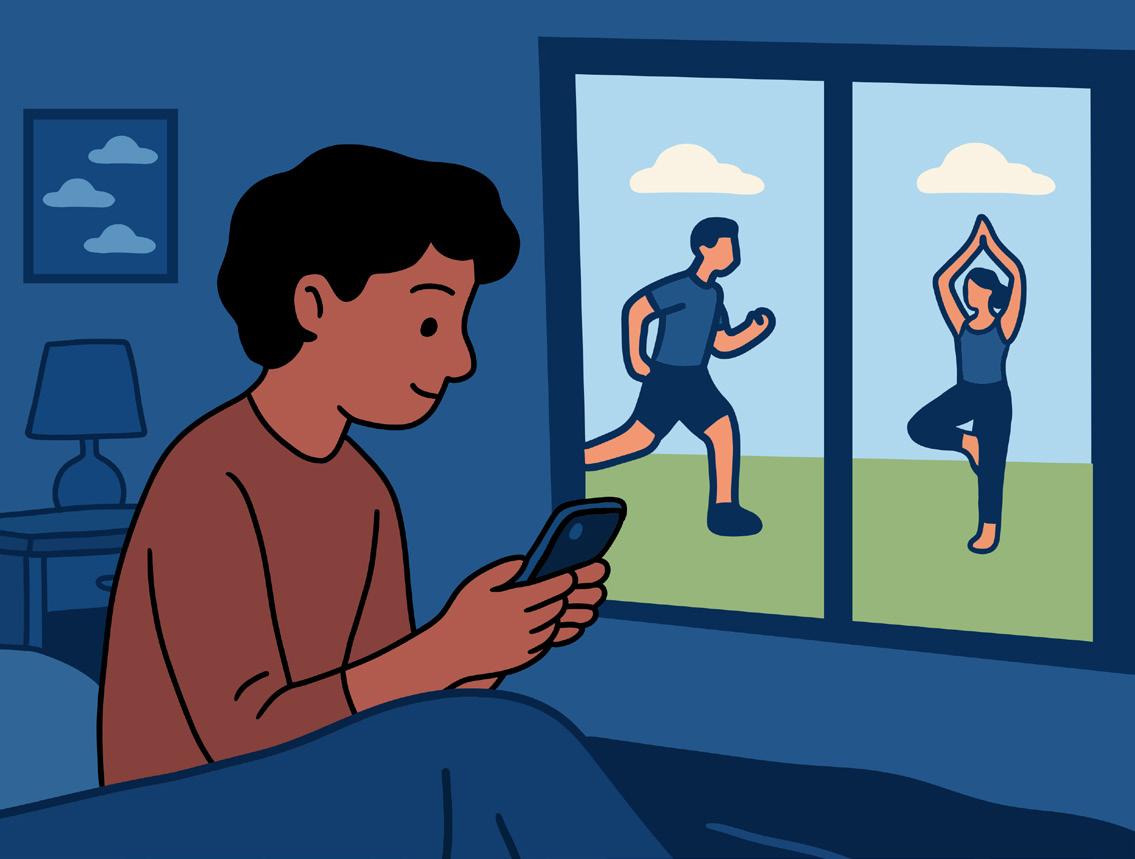
The most genuine connections you make at UM (probably) won’t come from having the same designer sunglasses as the person sitting next to you. They will come from meeting people who share the same interests and hold the same values as you.
So, instead of trying to fit into a watered down stereotype, try making genuine connections with the people around you. Join one of the hundreds of clubs and organizations on campus. From SCUBA diving to salsa dancing to gardening, you’re bound to find somewhere where you feel like you belong. If Greek life is more your thing, there are 33 sororities and fraternities currently recognized on campus. College is one of the few times in your life where you get to show up
and start completely fresh, and completely as your true self. You might find your group of friends in the sorority you never expected to join but were always interested in, or even just from walking to the dining hall.
One of the best things I have found from coming to college is being able to say “yes” to things I normally wouldn’t have and finding out that pretty much everyone else was also scared in the beginning.
The “UMiami girl” talk is just one small part of a bigger picture.
For every student scrolling through TikTok and Instagram wondering if you’ll ever truly fit in: you don’t have to change a single thing about yourself to belong here.
So, in case you were wondering — yes, you are a UMiami girl. Yes, you fit in as simply yourself.
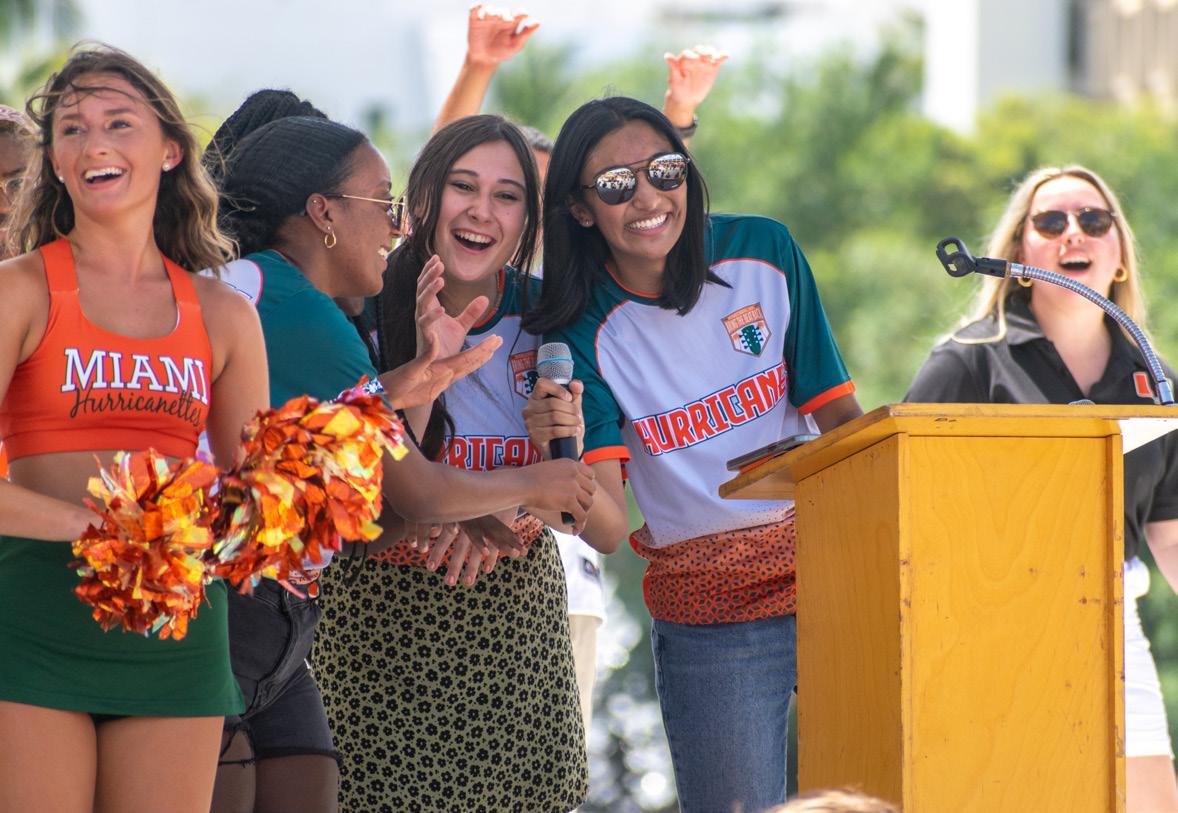
As UM students headed home for the summer, Kai Trump, one of our future athletes, made headlines for a scary reason. On June 3, a 23-year-old man hopped the gates of President Donald Trump’s Mara-Lago estate for a second time, wanting to speak to the president and marry his eldest granddaughter and UM golf commit.
The UM community must do its part to let Kai Trump be a student, allowing her to attend class and experience a normal college life. The disturbing incident reflects an unfortunate trend in which the families of presidents become targets of public scrutiny, stalking or worse.
While some of these relatives, like Donald Trump Jr. who even teased a presidential run, ask for the attention– most do not.
Malia Obama, Barack Obama’s eldest child, faced with a similar situation when she worked as an intern in the Tribeca office in New York. Chelsea Clinton, the only child of Bill Clinton, was called a “dog” at 13 by the late conservative talk show host Rush Limbaugh. The Bush twins, Jenna and Barbara, also faced intense scrutiny during their father George W. Bush’s two terms. The girls were both in college at the time and their activities were heavily documented.
Kai initially first gained public attention last year when she spoke highly of her grandfather during the Republican National Convention. Despite her debut being political, her content was mostly related to her lifestyle, including golf training, DC trips and other vacations, shying away from the family’s political spotlight. It’s important to remember that we are all human. People like Kai, and other political relatives deserve the same respect, privacy and security as everyone else.
This latest stalking incident is a stark reminder that the university must also be as cooperative as possible with Trump’s security team in order to ensure her safety on campus. Students should welcome her to the ‘Canes community with open arms, but should also respect her privacy. The University of Miami is no stranger to high-profile students, and the school prides itself on being a welcoming and inclusive campus. Let’s rise to that standard by giving Kai Trump the chance to be a member of the Hurricane family, free from the burdens of unwanted attention. We should respect her privacy both on and off campus, as well as supporting the university’s efforts to ensure her safety in light of the alarming breach at Mar-a-Lago. If we truly believe in community and respect, let’s show it. Let’s leave Kai Trump alone.
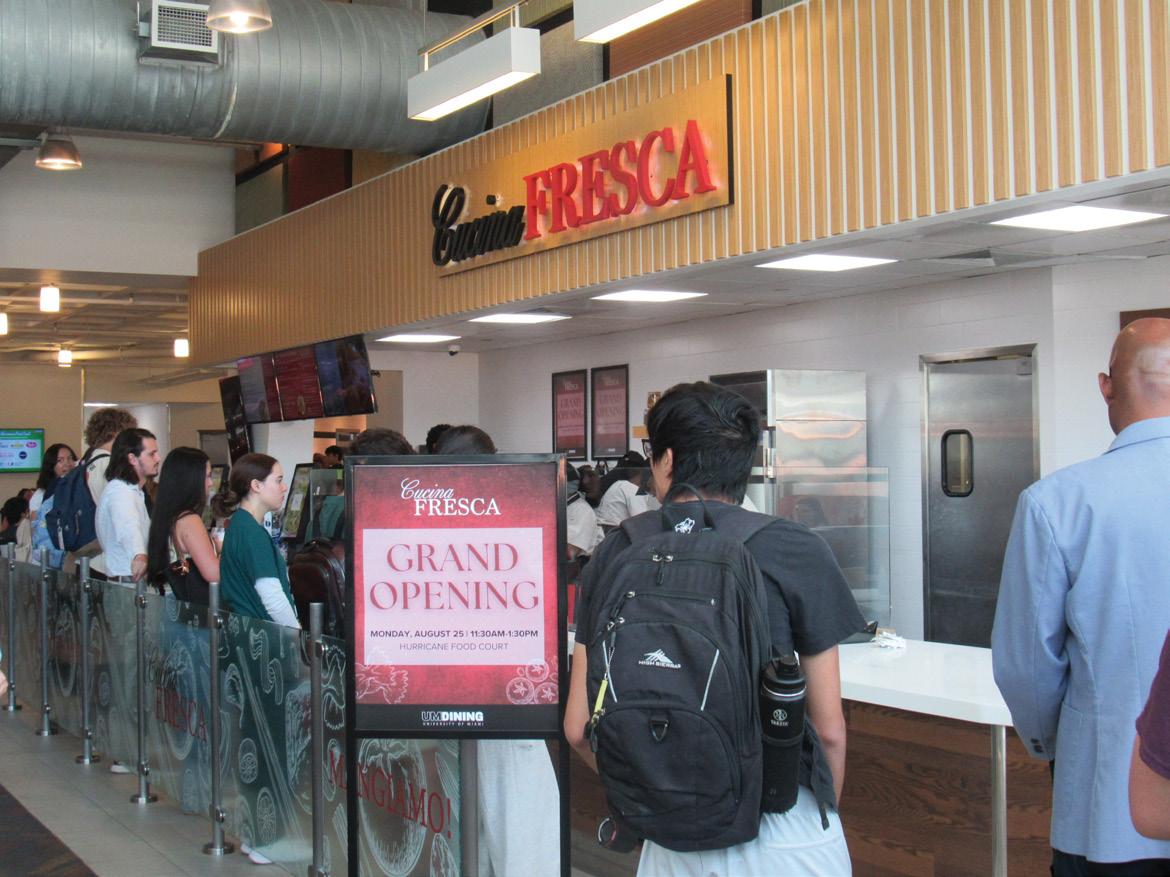
Kelby James // Contributing Photographer
Students order lunch at new food court spot Cucina Fresca on Monday, Aug. 18.
By Tatiana Pina Contributing Writer
Recognized by the Michelin Guide and featured on Good Morning America, Tinta y Café brings Cuban culture to Coral Gables through an elevated experience, inviting you to connect with your community or any curious tourists.
What looks like a small house from the outside creates an ambiance inside that feels like a family gathering.
Two siblings opened Tinta y Café in 2005 with a mission to elevate the iconic La Ventanita, a staple in cafecito and grab-and-go culture in South Florida. Perfect for a morning cortadito run, the walk up window honors vetantia tradition, yet still invites you to linger inside and take a dive into their rich menu and memorable space.
Inviting you to their warm and cozy interior, you can also choose to dine in at Tinta y Café. Though it tends to get very busy at noon, the wait to be seated is short. What seems like an homage to abuelitas jardín is an assortment of metal chairs, tables and shade provided by the palms to keep company while you get seated.
When you walk in, you’re greeted by the buzzing chatter of the families, coworkers and friends. When I dined in, I was shown to a long rounded dining table, also known as the communal table. This is another way the café encourages people to disconnect from their phones and connect.
Other options for seating were small tables or the bar where you can see your Cuban sandwiches being made. They also have a lounge area with leather chairs and a small coffee table.
The space is covered with multiple trinkets and books that resemble Miami Art Deco and Cuba’s culture. You are more than welcome to read any of the books or simply start a conversation with the stranger next to you.
Tinta y Café’s menu is recognized by Michelin for its twist on Cuban culinary pressed sandwiches. Featuring some Cuban classics like La Patriá – a hearty stack of ham, pork, mortadella, swiss, pickles and mustard. Each sandwich is served with a side of plantain chips that add a savory crunch. They serve enough to make you full, but you’ll still crave more.
Read more online at themiamihurricane.com.
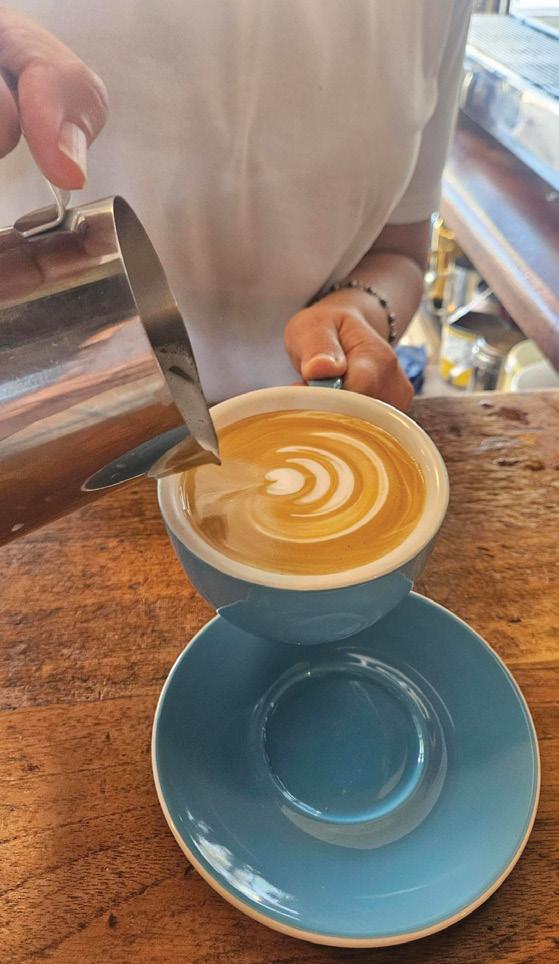
By Jenna Simone Asst. A&E Editor
With the start of a new semester comes busy schedules, long days and hungry students. Luckily, UM will be opening a brand-new dining option catering to Italian food lovers — Cucina Fresca.
Opening Monday, Aug. 18 at 11 a.m., Cucina Fresca is located in the Hurricane Food Court, making it a convenient stop between classes or for a casual dinner with friends.
A grand opening celebration is scheduled for Monday, Aug. 25 from 11:30 a.m. to 1:30 p.m. The restaurant’s hours of operation will be from 11 a.m. to 5 p.m. Monday through Thursday and 11 a.m. to 4 p.m on Friday.
Italian cuisine hasn’t had a place at UM in the past, so students are excited to see what it’s all about.
“I actually didn’t know they were opening a new place in the food court,” said Karina Desai, a sophomore business management major. “I’m excited to try it since we haven’t really had that type of food on campus yet.”
The menu features Roman-style pizza with toppings ranging from classics like pepperoni to more gourmet options such as prosciutto, meatball, pesto and chicken.
In addition to pizza, Cucina Fresca offers four different types of salads and paninis, including favorites like chicken parmesan and caprese.
“I’m gonna have to try each pizza option before the end of the
semester. They sound good,” said Lucas Velasquez, a sophomore math major.
Pasta lovers can enjoy comfort dishes like baked ziti and mac and cheese with sides like garlic bread and soup. For those with a sweet tooth, the menu also features gelato in four flavors — vanilla, stracciatella, coconut and pistachio.
“I’m looking forward to the variety of options Cucina Fresca has,” said Ava Ferrara, a media law major. “The menu seems pretty spread out and has a decent amount of savory and sweet options for students.”
Cucina Fresca is already drawing attention as a flavorful new addition to campus dining. Italian cravings are finally getting their moment at UM.
UM sisters build a brand , one cup of matcha at a time
By Jenna Simone Asst. A&E Editor
Every Tuesday through Thursday from 9 a.m. to 3 p.m., a sleek white truck parked outside the Cox Science Building drew a steady stream of students. With its signature matchas, lattes and small-batch baked goods that sell out fast, Honey Veil quickly became a goto destination last semester for matcha lovers on campus.
Founded by Miami-native sisters Ceci and Regina Alcobe, Honey Veil is a mobile café born out of a shared love for matcha and baking. At just 22 and 19 years old, the sisters have transformed a passion project into a popular campus staple, offering thoughtfully crafted drinks, sourdough pastries and a moment of calm amidst college chaos.
While you may not be shocked to hear that the drinks are delicious, you may be surprised to learn that both sisters and their older brother attended UM. This inspired Ceci’s decision to bring Honey Veil to UM. She felt like campus was the perfect place to start the business.
“Ceci did her research, reached out to the right people, and we got confrmation that we could be on campus two days a week,” Regina said. “She took the spring semester off to fully focus on Honey Veil, but she wanted to stay connected to campus — and this was the perfect extension.”
Behind the truck’s success is a story of resilience and inspiration rooted in family. The sisters cite their mom and multicultural background (Mexican, German and Spanish) as their most signifcant infuences. It all started when their mom, Cecilia, shared a photo of her sourdough bread in a group chat and received a food of orders. That led the
sisters to start selling baked goods at farmers markets.
What began as a two-day setup quickly expanded to three. Starting in fall 2025, the truck is expected to operate Monday through Friday.
The name “Honey Veil” originated from an unexpected source: ChatGPT. Regina, known for her love of descriptive writing, struggled to sum up the brand’s vibe in just a word or two. She typed out a long paragraph explaining their vision of something delicate, natural, sweet and intentional. AI suggested words like “honey,” “nectar,” “lace” and “thread.”
After mixing and matching, Regina initially landed on Honeylace, but the Instagram handle was taken. That’s when she found Honey Veil. She felt that the name captured their essence and even included a nod to Regina’s love of weddings.
Honey Veil stands out because of the intention and authenticity behind it. While their age might seem like a disadvantage to some, the sisters believe it’s one of their biggest strengths. Being young helps them connect with their audience and connect to their brand, from recipes to design to service with energy and meaning.
“I think sometimes when you take things too seriously, it’s hard to achieve what you set out to do because everything becomes about the destination — not the process,” Regina said. “We were so focused on enjoying the process and making that as authentic as we possibly could, and great things ended up happening.”
When it comes to their matcha, the sisters are perfectionists. Drinks are refned sugar–free and made with clean, simple ingredients. After conducting numerous tests, they perfected the matcha-to-milk and water-to-matcha ratios,

striking a balance between taste and froth in every cup.
Ceci led many of the matcha experiments. During this time, Regina accidentally invented their now-signature whipped honey, which was initially a failed attempt at a healthy meringue. While Regina keeps their recipes a secret, she’s always transparent about the ingredients.
As someone with a sweet tooth and a performance-driven mindset, Regina also began adjusting her recipes to cut refned sugar, opting for coconut sugar, maple syrup and more natural ingredients.
“I noticed that when I had too much processed food, I would break out, bloat and just not feel my best,” Regina said. “We never wanted [our food] to be about ‘low-calorie’ — it’s about real, whole foods that help your body feel good while still tasting amazing.”
Honey Veil even offers gluten-free and dairy-free options.
Flavor creation is one of Regina’s favorite parts of the job, even though she doesn’t have as much time for it now.
“I have an endless document of favors that have popped into my head and I’ve been wanting to test and try out,” Regina said. “A lot of them come to me when I’m working on the truck, or when someone mentions something, or I’ll see a TikTok with a cool dessert recipe and imagine it in a drink with a different twist.”
Right now, she’s still heavily involved in the day-to-day operations, but plans to regularly release new and exciting favors in the near future. One of her biggest inspirations is Hallie Meyer, founder of Caffè Panna in New York, who is known for her creative ice cream combinations.
“Her favor concepts always blow my mind — I look up to her so much,” Regina said.
The sisters’ dedication goes beyond recipes. One of Regina’s most memorable days on the truck came when she gashed her foot open with a syrup bottle. She had no choice but to bandage herself up, prop her foot on a stool and keep working through the pain.
“It was honestly pretty painful working like that for hours, but the constant fow of matcha and conversation with students kept the pain at bay,” Regina said.
Despite needing crutches for two days, she was back in the truck shortly after.
“One of the girls told me, ‘Thank you for coming back,’ and those words meant the world to me,” Regina said.
Operating a food truck comes with its own set of challenges including permits, logistics, weather and power outages. But the sisters have built a strong system and learned to adapt.
As former competitive tennis players, Ceci and Regina were enrolled in online school to travel for tournaments, training fve to six hours daily. The discipline and sacrifce tennis demanded taught them the necessary skills for run-
“We
were so focused on enjoying the process and making that as authentic as we possibly could, and great things ended up happening.”
Regina Alcobe Co-Founder of Honey
ning a business.
“I think tennis gave me the skills to persevere, adapt and be consistent no matter the circumstances,” Regina said. “You have to master what you can control so you’re always ready for the unknown — whether it’s on the court or the truck.”
Regina was even talking with Division I tennis programs before Honey Veil took off but ultimately chose the café over a collegiate athletic career. She’ll begin at the University of Miami in fall 2025.
UM students have been some of Honey Veil’s most loyal supporters and a major reason the sisters have pushed forward.
“There have been a lot of hard days that made us doubt,” Regina said. “But the students were always there — showing up, talking with us, giving us their energy.”
The sisters never set out to specifcally “market” to students, but the connection came naturally.
“I credit them more than I credit us — for taking a chance on us and supporting us every step of the way,” Regina said.
That connection helped cement Regina’s decision to attend UM this fall.
“I think I resonate with our customers because I am our customer — young, curious, a little bit confused about the world, but with a hunger to learn and be so much more.” Regina said.
From a trending sourdough craze to a sleek campus truck, Honey Veil is more than a café. It’s a story of sisterhood, vision and passion sweetened with a little whipped honey on top.
As the truck’s following continues to grow and its menu evolves, Honey Veil is proving that thoughtful ideas, genuine connection and a bit of boldness can go a long way even without formal training or years of experience. With every pour, swirl and smile, the Alcobe sisters are building community, one matcha at a time.
Venetian Pool makes a splash with centennial renovation
By Jenna Simone Asst. A&E Editor
The iconic Venetian Pool, just minutes from UM’s campus, underwent major renovations ahead of its 100th anniversary. It is the only swimming pool listed on the National Register of Historic Places, so preserving its Mediterranean architecture and charm was important.
The city chose ecoFINISH®, a modern, high-performance pool coating company to complete the job.
In its early days of opening in 1924, it was called the Venetian Casino. The Venetian Casino came from George Merrick’s plan to create a city that would embody authentic hometown
living. Merrick was a key fgure in early 20th-century urban planning of Coral Gables. He wanted to create a city with Mediterranean elements like grand entrances and plazas, complemented by homes in a matching architectural style. To execute this vision, the limestone on many buildings was taken directly from a quarry pit. Merrick, artist Denman Fink and architect Phineas Paist transformed that quarry into the Venetian Pool. In the 1920s, the “Venetian Casino” was a destination for people of high social status, including movie stars. The pool was also a site for orchestra concerts and would be emptied so they could perform on the pool foor.
The recent renovations include installing a new water recirculation pump
system, a frst for the pool, which allows the city to maintain water quality without draining the pool daily. The system is a precautionary measure against potential issues like saltwater intrusion or water shortages. Restoration efforts also involve updating outdated pump equipment and renovating the concession area. Islamorada Pools, a Florida-based contractor with strong local ties and a track record of high-profle pool renovations, applied a new coating to seal the pool foor.
The project has reduced chemicals and water loss by 40%, making it a major sustainability win for the city and pool goers.
The pool continues to draw signifcant interest with nearly 65,000 visitors annually before its closure. The pool re-

mains unique as it continues to be flled
By Valeria Palladino Contributing Writer
Seems like the internet can’t decide, is it genius or a joke?
Some say “Dancing with the Stars” made a strategic move by adding Alix Earle – a possible major ratings booster. Others are asking, “Who is she?”
It all started with a single announcement post followed by a wave of backlash. Comments like “she’s not a real star,” “I wish they had chosen actual celebrities” and “the show is completely washed up” are only a few.
What do ’Canes have to say?
“I’m not opposed to the idea, I just think it’s different because, usually, it’s celebrities who appear on the show,” Gaby Abudoj, a communication studies major, said. “I’m intrigued to see how this goes. It’s an example of how someone who starts
out as just an infuencer can become something much bigger.”
Abudoj points out that Alix Earle started posting short videos on Tik Tok and is now being invited to ce lebrity-exclusive events and parties. Most people do know who she is, whether they want to admit it or not. This shows tremendous growth and it’s a lesson to all students that lit tle videos can go a long way if done correctly.
Other students agree the move is tactical but question the consequenc es.
“It’s defnitely a strategic move, no questions there. But they’re changing the whole idea of the show and who they invite after. Will it just be infuencers in the future?,” Gaby Bueno, a senior at UM, said.
Bueno argued the core idea of “Dancing with the Stars” is to pair professional ballroom dancers with celebrities. While celebrities can also be infuencers,

not all infuencers are celebrities. If they start accepting infuencers such as Alix Earle, what will
By Sebastian Font Co-Sports Editor
Just a year ago, ’Canes fans eagerly awaited the Hurricanes to kick off their opening game against Florida, ready to see their new-look team shaped by the transfer portal take the feld in a pivotal year for Head Coach
Mario Cristobal.
By all accounts the offense was an absolute success (frst in total yards and points per game), boasting a Heisman candidate in QB Cam Ward and veteran weapons across the board.
And yet with all this frepower, UM ended up with nothing to show for it.
Two losses late in the season ended the ’Canes playoff and ACC championship hopes, resulting in an appearance in the Pop-Tart Bowl which Miami still fell short in.
The 2024 Hurricanes unfortunately followed the same path as the 2017 Hurricanes who missed the CFP with two late ACC losses.The 2018 Hurricanes continued the downward spiral as they fell to a 7-6 record which marked the end of the Mark Richt era. Miami cannot afford a repeat of the 17-18 cycle in 2025.
This season needs to break away from the trends, end the “Miami can’t win in November” narrative and continue the progress coach Cristobal has made every year.
And in year four of the Cristobal era, he’s brought together a squad that can do just that.
Old-school offense
Last year’s offense was generational, something that no team can repeat in back-to-back years, especially when a team loses nearly all of their skill positions to the NFL via the draft and free agency.
The staff understood the challenge they faced, and rather than try and replicate, they focused on elevating the foor of the team.
At the core, this is a run-frst team with one of the greatest offensive line rooms in Hurricane history to protect electric running backs in Mark Fletcher Jr. and Jordan Lyle.
This team can run the ball at will, any time and any place — so the staff brought in veteran pieces to complement the run-game.
Georgia transfer QB Carson Beck fts the scheme perfectly, a quarterback who has all the talent in the world, but is willing to let the run game shine. He’s consistently shown his complementary nature to high powered run games at Georgia, and can replicate
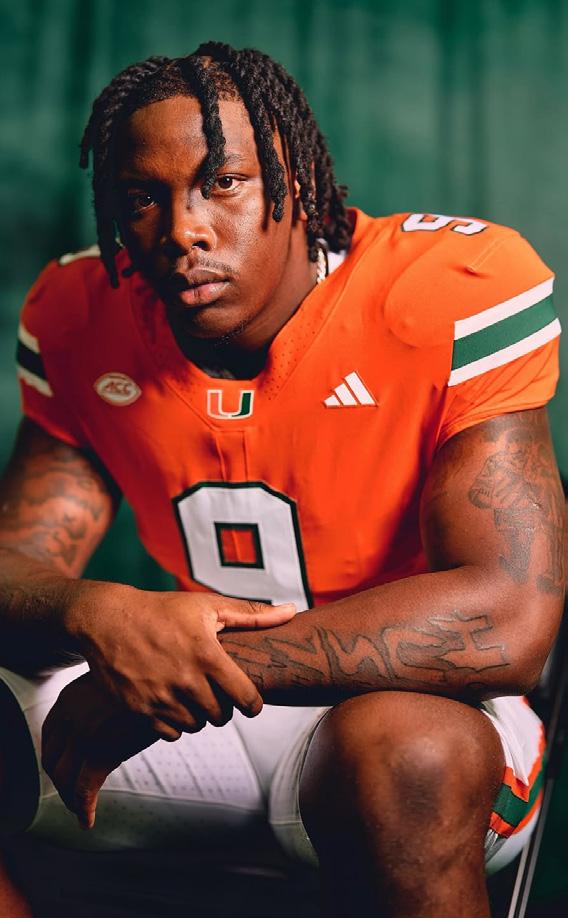
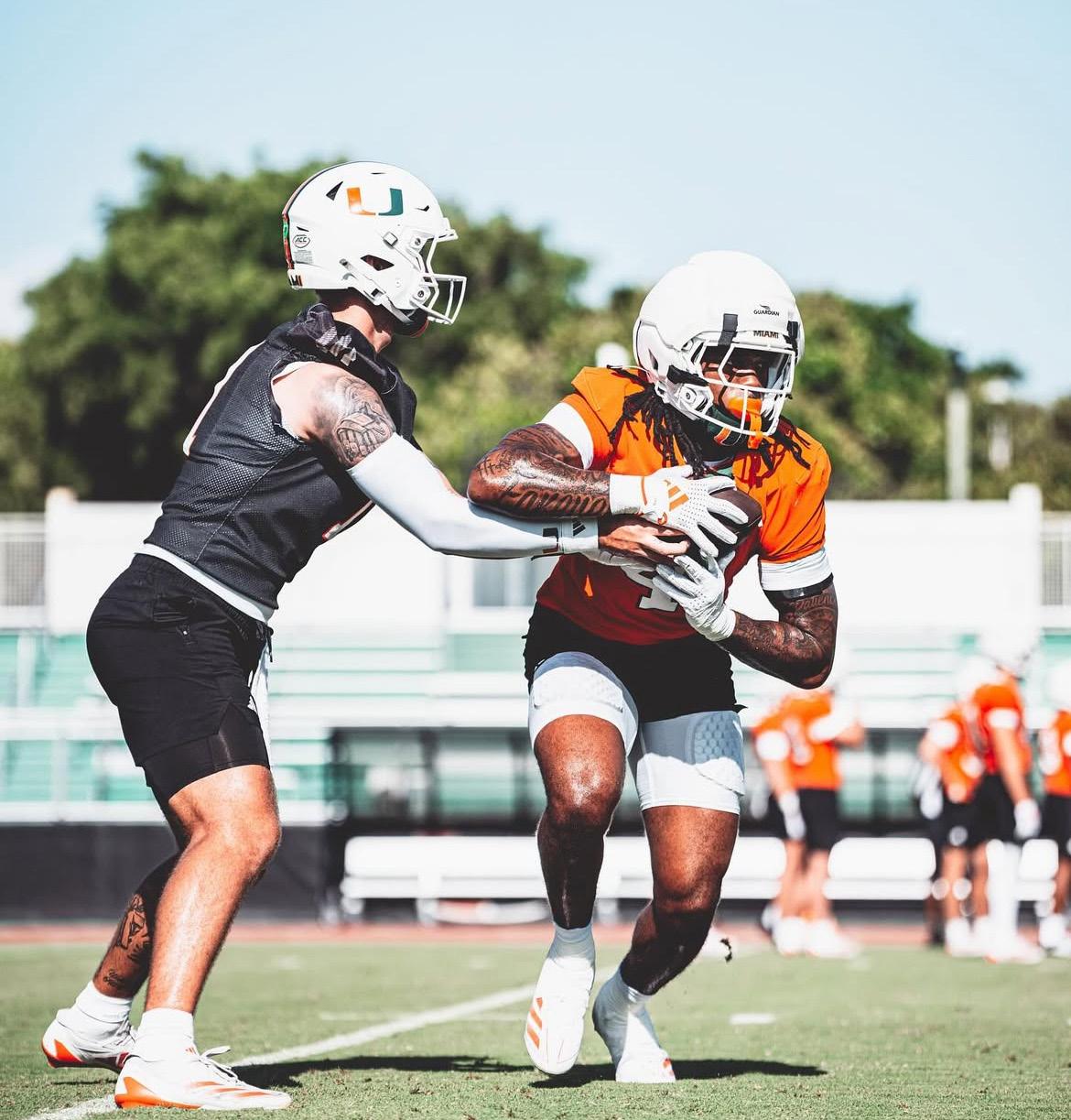
that at Miami.
He’s throwing to other veteran transfers with WR CJ Daniels and TE Alex Baumann, who both have demonstrated clear chemistry with Beck throughout fall camp.
And while this team has a high foor just off the veteran play, the ceiling is completely untapped with the rise of young talent.
Wideout Joshisa Trader has all the tools to take the next step during his sophomore year alongside fellow sophomore Elija Lofton who is truly a “swiss army knife” at the tight end position.
Add in the budding freshman wide receiver pair of Malachi Toney and Josh Moore, it becomes clear that Miami has true depth and talent across the board.
While it may not be as fashy as the Cam Ward led offense last year, this offensive roster can still fnd ways to dominate the opposition.
A revamped defense
Even before getting into the talent on the defensive side of the ball, it’s worth mentioning the coaching changes that have occurred.
Former Minnesota defensive coordinator Corey Hetherman was hired for the same role in Coral Gables and has had nothing but glowing praise from the players.
“Well, we’re communicating a lot better. I think guys are starting to build a lot more chemistry,” said sixth-year senior DE Akheem Mesidor. I love this defense, it’s simple. I get to go inside and out, I’m so happy.”
“Simple” is the word consistently used by players and staff alike whenever they refer to Hetherman’s scheme.
Too often, we’d see miscommunication across the defensive levels last season under former DC Lance Guidry, which left players exposed and teams would capitalize at will.
Hetherman’s simplicity is exactly what the doctor ordered to fx the defense from last year.
And when it comes to the players, the talent has gone through the roof.
Headlined by former Freshman All-Americans DE Rueben Bain and DB OJ Frederique, the Hurricanes have proven home grown talent at multiple levels. Add in the defensive lineman in the
it’s really cool that she’s joining, I will for sure watch that,” Terceros said.
And the numbers don’t lie. People are tuning into the decades old show with its last season averaging one of their biggest audiences, around 6.36 million viewers. Meanwhile, Earle’s TikTok videos to her 7.5 million followers average 1 million likes. These rising stars seemed destined to collide.
Valerie Marriaga, an industrial engineering senior, thinks it will be entertaining to see her progress throughout the show. She believes Earle’s presence will add not only entertainment value but also more behind-the-scenes content with her iconic “Get Ready with Me” Instagram videos and storytimes. Most students agree that adding Alix Earle is a smart move for “Dancing with the Stars” in terms of boosting viewership, but not everyone likes what it implies for the show’s future. The debate isn’t really about who she is but what she is: an infuencer.
form of Justin Scott and Akheem Mesiddor, Miami has a staunch front line that can create chaos in the backfeld.
Even the linebacker room has improved, adding veteran Mohamed Toure to partner home-grown senior Wesley Bissainthe.
But the most improved area is undoubtedly the secondary.
Despite Frederique having a stellar season last year at corner, beyond him the room was thin and truly cost the team. The staff completely fipped this room in the offseason via the transfer portal with a long list of additions:
Xavier Lucas, Ethan O’Connor, Zechariah Poyser, Keionte Scott, Jakobe Thomas
Each of these players were crucial starters for their respective programs last year and a clear upgrade over the players Miami had last year.
Lucas in particular could be one of the best corners in the ACC after an impressive year at Wisconsin, part of why Wisconsin has tried so hard to keep him and eventually sue Miami for landing him in the portal.
With an injection of talent and a player-friendly scheme, Miami has transformed its defensive room from one of the worst in the country to arguably one of the best — which could be the catalyst for a successful Hurricanes season.
But what does this all mean? Like last year, Canes’ fans sit eager and ready to watch the ’Canes take on a rival for opening day.
This time it’s Notre Dame, a proven top-ten force who fnished runners-up last season to Ohio State.
While it may be daunting, from top to bottom this is the best roster Cristobal has brought together. Experienced veterans are scattered across the feld alongside budding youngsters who both yearn to prove themselves on the biggest stage. The foor for the Miami Hurricanes has time and time again been raised under Cristobal with his talent acquisition.
At some point, the Hurricanes need to get over the hump and prove that they’re back, and a signature win at home would go a long way.
By Mary-Grace Cardelle Sta Writer
After a long and busy offseason, UM’s women’s soccer team is gearing up for an optimistic 2025 season.
Led by head coach Ken Masuhr
— who is entering his second season with the ‘Canes — optimism continues to grow around the Coral Gables squad as the Hurricanes continue to push towards the top in the ACC.
Offseason talent acquisition
Masuhr and his staff have worked diligently this offseason, assembling a team that blends players of different backgrounds and strengths.
Last year, Miami relied on a core group of starters who we saw frequently. The new recruitment boost allows for the team to have more stable rotations throughout the 90 minutes, fresher legs and hopefully less injuries.
Sarah Greiner, one of the new additions, is a forward transfer who spent her first two collegiate years at Tennessee. Greiner holds electric statistics dating back to high school — awarded 2023 Region 8-AAAAA Player of the Year and setting her high school’s single-season goal record. At Tennessee, she appeared in 17 matches, and scored a game-winner in a critical 1-0 victory that secured her team a spot in the SEC tournament.
Another notable addition is midfielder Emilie Simpson, an international transfer from England.
A past Arizona State starter, Simpson has also played for the England National Team and won a national championship with WSA Arsenal.
”These [transfers], along with our signings for the 2025 class,
will further add to the framework we are creating and the standards we set and continue to raise,” Masuhr said.
The added talent, mixed with the returning teammates, will provide strategic flexibility for the team during key game moments. Moreover, the mix of experienced and younger players will allow for sustained future growth and continued excellence under coach Masuhr.
Defending home turf
Another key factor for the Hurricanes’ season relies on their home field advantage. Miami hosts four big games against top tier ACC competition at Cobb Stadium, which could be crucial to their success. Their final home game of the season is set to be against North Carolina, the reigning national champions, on Thursday, Oct. 23.
While the ACC competition, especially at home, will be a major component in how they perform, their non-conference play is also extremely important to set the tone for ACC play.
Building momentum for non-conference opponents can give the squad confidence to perform against higher ranked opponents in the ACC.
The Hurricanes have a long season ahead — with a lot to prove and a challenging schedule — but this incredible roster will help them compete in the talented ACC.
Despite not qualifying for postseason tournaments, the 2024 season was Miami’s best effort since 2018-19. The Hurricanes are hoping to build off of that success from last season and ideally even qualify for a postseason run in coach Masuhr’s second season at the lead.
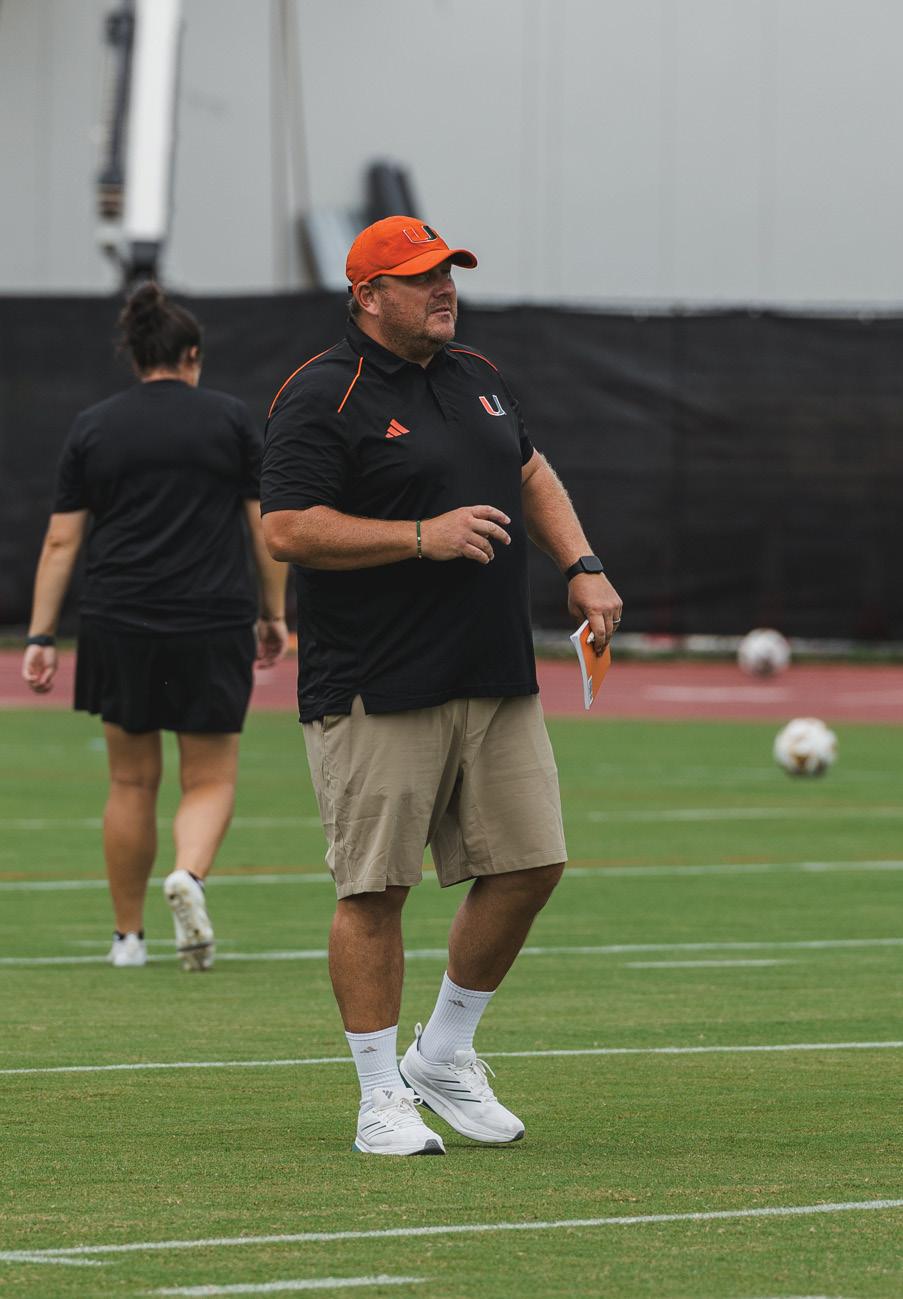
By Zach Cohen & Sebastian Font Senior Sta Writer & Co-Sports Editor
The Hurricanes will be a newlook side heading into their opening game against rivals Notre Dame. With a roster heavily influenced by the transfer portal and freshman recruiting class, here’s how the ’Canes could line up heading into head coach Mario Cristobal’s fourth season at the helm:
Quarterback
Carson Beck #11, QB1
All eyes are on Miami’s new quarterback heading into the 20252026 season. Carson Beck, a top transfer from the University of Georgia, has some big shoes to fill after Cam Ward’s Heisman finalist campaign last season. The Jacksonville, Fla. native threw for 3,485 yards and 28 touchdowns, alongside an 11-2 record last season. He helped lead the team to an SEC Championship win and a college football playoff berth in his final season as a Bulldog.
As a part of two national championship-winning teams and finding success as a starter the past two years for Georgia, Beck looks to bring his winning mentality to Coral Gables and win Miami their first ACC championship ever.
Wide Receivers
CJ Daniels #7
The most experienced wide receiver on the team, CJ Daniels, enters his sixth year of college football. He brings much-needed experience to a young wide receiver room.
Daniels played his first four seasons of college football at Liberty University, where he put up great numbers. In his final season with Liberty in 2023 , Daniels caught 55 passes totaling 1,067 yards with 10 touchdowns and was named to the 2023 All-Conference USA Second Team. While his stats were down last year at LSU due to a foot injury, Daniels has fully healed and aims to return to his 2023 form in Coral Gables.
Running Back
times on the ground, a true redzone threat.
Fletcher Jr. hopes to do big things as the No.1 back for Miami this season.
Tight End
Elija Lofton #9
A native of Las Vegas, Nevada, Elija Lofton looks to step up into a bigger role this season after improvements throughout the offseason.
In his freshman year (2024), Lofton showed promise with his versatility in all 13 games. He caught nine passes for 150 yards, including a touchdown. He also took snaps from the backfield, having two rushes for 30 yards and a touchdown. Lofton’s size and strength will be a nightmare for opposing teams’ defenses in 2025.
Offensive Lineman
Francis Mauigoa #61
Francis Mauigoa looks to continue a dominant career at the U.
As a sophomore (2024), Mauigoa and his other offensive lineman led Miami to the No.1 offense in the country, blocking for Ward. He started in all 13 games at right tackle and earned All-ACC second-team recognition as one of the conference’s top linemen. Over the course of the season, Mauigoa led Miami to several 500+ yard performances, including a big opening weekend defeat versus Florida, where the offense amassed 529 yards.
Defensive Lineman
Rueben Bain Jr. #4
After an impressive freshman campaign where Bain received Freshman All-American honors alongside being named the ACC Defensive Rookie of the Year, he dealt with a lingering injury last season that limited his production. Despite missing four games due to a calf injury last season, Bain still finished the season with an impressive 23 tackles, 5.5 tackles for loss, and 3.5 sacks. Now fully healthy and a projected top-10 draft pick, Bain looks primed to have a standout year as the anchor of the Hurricane defense.
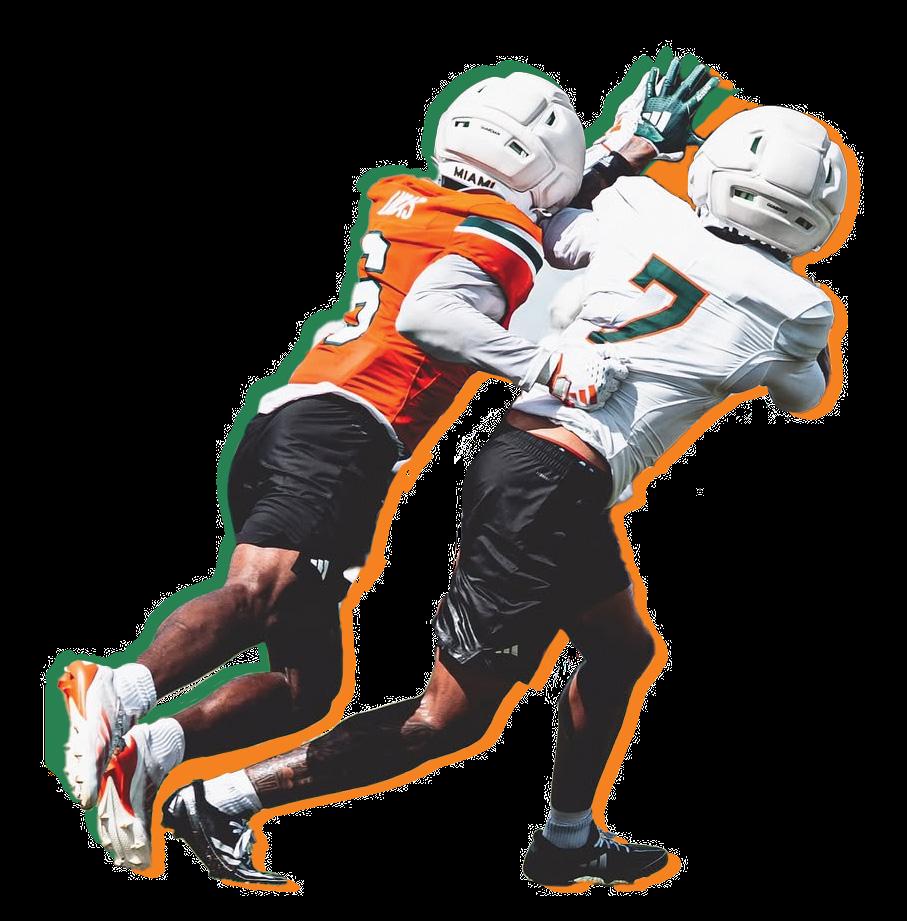
Mohamed In early May, Miami landed a transfer com -
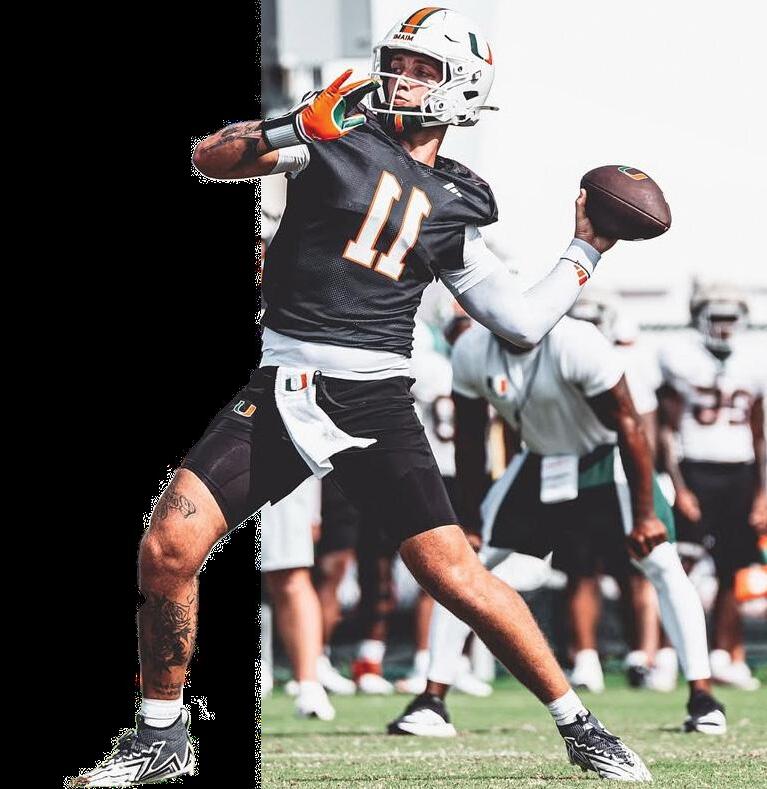
simply because teams were afraid to throw it Frederique’s way.
Lengthy, instinctive and physical when needed, expect Frederique to continue shutting down his side of the field alongside an improved secondary room.
Safety
Zechariah Poyser #7
A top player in the transfer portal, Zechariah Poyser joins the Hurricanes after two seasons with the Jacksonville State Gamecocks. With the Gamecocks, Poyser was named Freshman All-America by the Football Writers Association of America as a redshirt freshman in 2024. In that year, he had 75 total tackles (47 solo) with three interceptions and eight tackles for a loss. He was rewarded with C-USA defensive player of the week after a stellar game against Kennesaw State.
Special Teams
Kick return: Keelan Marion #0
Over the past few seasons Miami has lacked the “it” factor on kick returns, but appear to have flipped the script with one portal class. A former All-American return man, Marion provides electric return possibilities for the Hurricanes.
Don’t be surprised to see him change the game with their return ability this fall.
Kicker: Bert Auburn #45
Following the Borregales brothers success as kickers during the 2020s, Miami was left with big shoes to fill at the kicker position.
Last season Andy Borregales had a remarkable season with only
vs. Notre Dame Hard Rock Stadium vs. Bethune-Cookman Hard Rock Stadium vs. USF Hard Rock Stadium vs. Florida Hard Rock Stadium at Florida State Tallahassee, Fla. vs. Louisville Hard Rock Stadium vs. Stanford Hard Rock Stadium at SMU Dallas, Tex. vs. Syracuse Hard Rock Stadium vs. NC State Hard Rock Stadium at Virginia Tech Blacksburg, Va. at Pittsburgh Pittsburgh, Pa.
Miami Hurricane volleyball is coming off a solid 2024-25 season after a 22-11 (ACC 12-8) record with a first round tournament win over the South Dakota State Jackrabbits before falling to Nebraska in the next round.
The ’Canes are led by head coach Jose “Keno” Gandara, who is heading into his 13th year at Miami. He is aiming to make the NCAA tournament for a fifth season in a row. As the season gets underway, here is a look at how the team is shaping up.
Locker room full of new faces
The Hurricanes lost five players to the portal last off-season, including the team’s second leader in kills, Grace Lopez, who joined the Wisconsin Badgers. In addition to those lost to the portal, the ’Canes also lost a significant part of their roster for other reasons including graduating players. With this, Miami only returns five players out of a team of 17 from last season.
The Hurricanes have filled the void in the roster with five transfers, sophomore Kate Lijic (Utah State), sophomore Logan Wiley (Georgia Tech), junior and Miami native Gaby Arroyo (Dayton), graduate students Lilou Stegeman (American University) and Jazmin Vergara (Tennessee State), and six freshman.
These new faces must mesh well together if Miami hopes to achieve another winning season.
Star returns for senior season
A huge win that came during the off-season for UM was the unexpected return of their star player, senior Flormarie Heredia Colon. Why was this unexpected? Because during last semester, Heredia Colon had transferred over the Florida Gators. However, she changed her mind and has come back to Miami ready for his senior season.
The powerful hitting player from the Dominican Republic dominated the court last season as she was named to the All-ACC First Team. She was also second in the ACC for kills and points at the end of the year. In addition to her impressive ju -
nior year statline, Heredia Colon is also eighth on UM’s all-time career kills list with 1117 – a number likely to only grow.
Who could the starters look like this season?
The setter seems like the safest pick with returning redshirt sophomore Ariana Rodriguez is more than likely keeping her spot after a great season last year. Dalia Wilson, a main middle blocker and returning senior, is experienced and was third on the Hurricanes in kills last year with 159. However, Stegeman and Wiley should get significant playing time as well. . The libero will either be four year ’Cane, senior Naylani Feliciano or the Dayton transfer, Arroyo. As long Heredia Colon does not need a breather, she will be on the court as an outside hitter. As for the other outside hitter, players like returning junior Ava Carney and Tennessee State transfer Vergara could compete for some playing time. With a squad where the majority consists of new players, there is potentially a lot of playing time up for grabs.
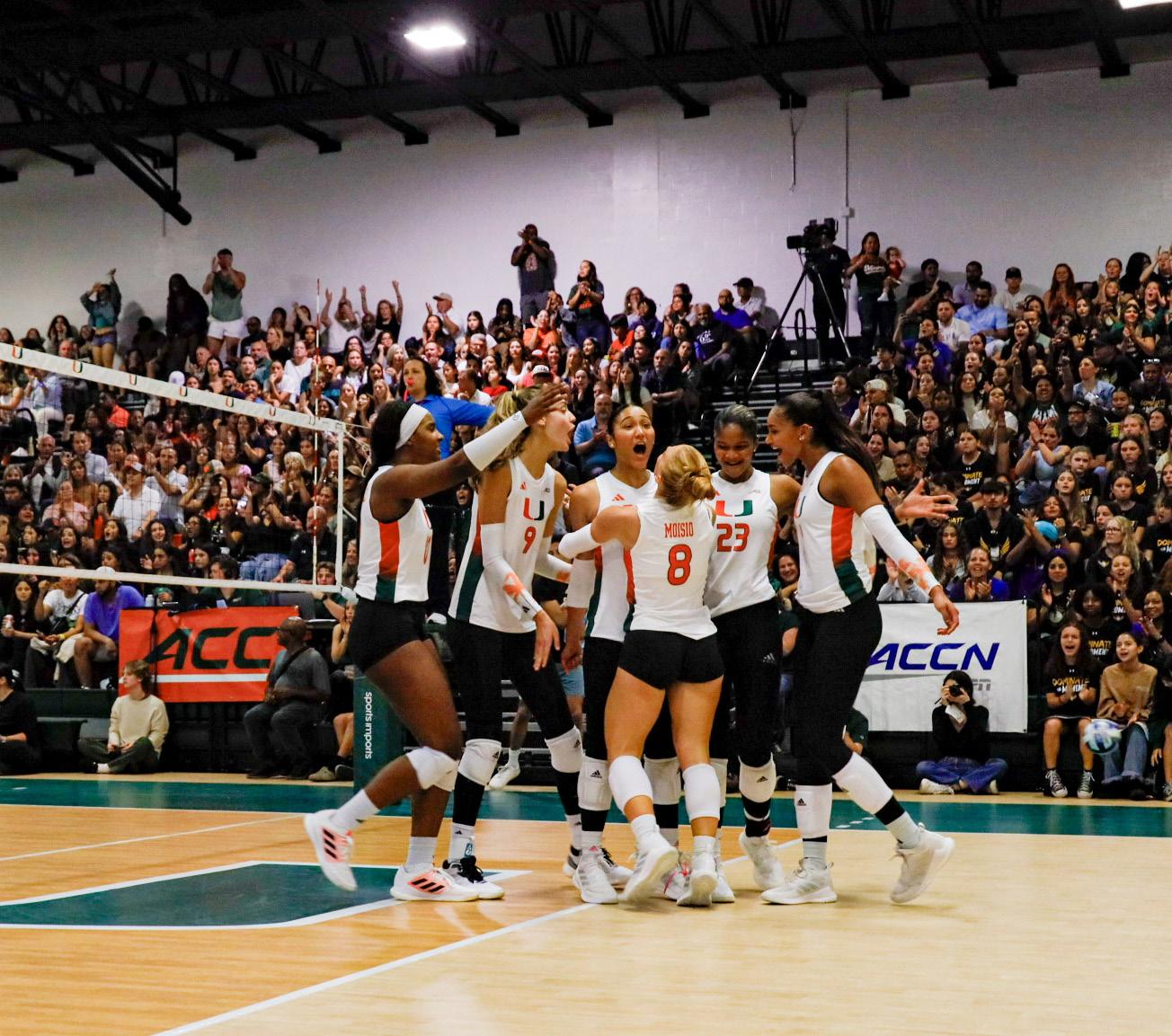
V’s Take is The Miami Hurricane’s most controversial and longest running column.
V’s Take is a satirical work published biweekly by students and for students using our generation’s “colorful” language. V addresses all things love, sex and gossip on campus. V is not for the politically correct or easily ofended.
I
my
Look, we’ve all been there. Even I’ve drunkenly dragged someone back to my room, only to find my roommate already twisting in the sheets with the night’s sidepiece of choice. For those times you’re desperate to get your jeans off and get into someone else’s, V has just the spot for you to hit the G.
The arboretum
If you don’t mind getting mosquito bites and poison ivy on your privates, this is the place for you. The cicadas compensate for the lack of mood-setting music, so your boo may not even notice you calling them by the wrong name.
The stacks If you’re down to play the silent game, give the stacks a whirl — and a view of your bare ass on the books.
While I haven’t tried this one myself, I’ve heard the bookshelves provide some great support for your late night “study date.” And when it inevitably goes south, the stacks even has some great psychology books so you can read them and convince yourself you were gaslit.
The third floor Shalala
The most luxurious of my suggestions, Shalala comes equipped with couches and a multi-million dollar view of Centennial Village. If you can manage the drunken trek up the two flights of stairs, Shalala’s back corner will welcome your open legs with open arms.
The roof of Pavia
If someone has ever turned to you and said “I know a spot,” they’re probably trying to take you to their backseat for some backshots. Be warned, Lakeside residents can see everything even through your bae’s heavily tented windows.
The IM Fields
Especially with the construction blocking the majority of the view, if you can manage to stumble your way onto the field this is the perfect place to keep your sneaky link sneaky. You won’t be the first person — and you certainly won’t be the last — to use the grass instead of a mattress.
Your friend’s room
This one takes some careful planning and execution. If you’re getting kicked out of yours, double it and pass it to the next. Just kick your friend out of theirs! At the very least, make sure they have some noise-cancelling headphones on.
So, what are you waiting for? Grab your favorite nighttime companion and make some memories. They say experience is the best teacher, so get out and explore UM’s beautiful campus while exploring someone’s mouth.
